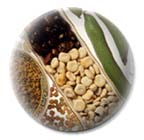- Home
- Introductions

|
Vegetable Seed Production: CeleryYou are here: Seed Production: Apiaceae:
Celery
Botany Family Apiaceae (Umbelliferae is the old name.), Apium graveolens. Celery is a cool season biennial that is grown as an annual. Hardened plants can briefly withstand temperatures a few degrees below freezing. The plant is easily vernalized by exposure to temperatures less than 50 degrees F after it has developed passed the juvenile phase. The vernalized plant quickly produces a flower stalk (bolts) that inhibits further stalk development. Unless the crop is being grown for seed, bolting (flowering) ruins the economic value of the crop and must be avoided. During the first year of growth, celery forms, a short subconical stem bearing a spiral rosette of leaves on the end of an elongated petiole. Generally, the petiole is the most important edible portion. The petiole is cresentric in transection with prominent ribbing on the abaxial (inside) surface and a relatively smooth adaxial (outside) surface. The ribbing is a result of bundles of collenchyma on the abaxial side. The collenchyma bundles along with the vascular bundles that run through the center of the stalk are responsible for the stringiness of celery. Botanist Katherine Esau demonstrated that the collenchyma is mechanically a very strong tissue, being about four times as strong as the vascular tissue.
Soil Nutrition
Isolation Because of the high possibility of cross-pollination, isolation distances for commercial seed crops should be a minimum of 800 m. For basic seed the distance should be greater, about 1600 m. Planting Celery seeds are very small, slow to germinate, and emergence is very irregular. Therefore, celery is always field planted using 4 to 6 week old transplants. Plug tray transplants are most commonly used. Irrigation
Roguing Celery roguing, stages and characters to check 1. Planting out: Leaf and petiole characters, plant vigor
Seed Harvest The seed crop is ready for harvesting when the plants show signs of senility and the majority of seeds on the major inflorescenses have become a gray brown color Celery seed is notorious for shattering prior to harvest even in the best of conditions and a lot of valuable seed can be lost if bad weather occurs or the cutting time is misjudged. When produced in tunnels or relatively small areas outside, the plants can be pulled or carefully cut and placed on tarpaulins. In large-scale production the crop is carefully cut, dried in windrows and combined before excessive shattering has occurred. Cleaning If a combine is not used the material can be passed through a stationary thresher, but if dried on tarpaulins, especially under cover, the seed separates from the straw without machine threshing. Seed is further cleaned by an aspirated screen separator, but because the seed is very small, care must be taken in selection of the bottom screen. Seed Yield The average seed yield is about 500 kg per hectare (446 lbs/acre). Seed weight: the 1000 grain weight of celery seed is approximately 0.5 g. Seed Identification:
|
||||||||||||||||||||||